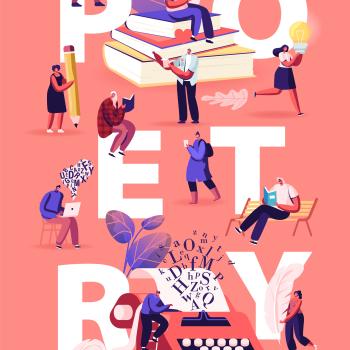What Makes Poetry? Exploring Line Breaks

- Preview |
- Standards |
- Resources & Preparation |
- Instructional Plan |
- Related Resources |
- Comments
Overview
Students brainstorm the characteristics of poetry, then focus in on line breaks. As a group, they analyze the use of line breaks in the poem "Bubbles," noting how they affect the sound, meaning, and appearance of the poem. Students then work in small groups to explore the line breaks in two additional poems, reading them aloud, discussing the line breaks, and experimenting with changing them. Finally, students come together as a group to discuss what they have found.
From Theory to Practice
In their survey of articles about poetry published in the English Journal, Mark Faust and Mark Dressman identified a significant history of what they termed a populist view of poetry: "Populists see poetry as something to be used, adapted, cut up, borrowed from, parodied, and played with in all sorts of ways. Rather than belonging to the ages, poetry is a popular expression of culture that belongs to anyone who chooses to read it. Students are invited to collect poems and organize them in ways they find meaningful, to read them orally and chorally, to write their own poems, and to otherwise muck around with poetry and poetic language and in the process gain some skill in using the English language by taking pleasure as much in their own as in the poet's cleverness." (117) This lesson invites students to make poetry their own by playing with line breaks. In the process, students learn how line breaks can influence the rhythm, appearance, and meaning of a poem.
Further Reading
Common Core Standards
This resource has been aligned to the Common Core State Standards for states in which they have been adopted. If a state does not appear in the drop-down, CCSS alignments are forthcoming.
State Standards
This lesson has been aligned to standards in the following states. If a state does not appear in the drop-down, standard alignments are not currently available for that state.
NCTE/IRA National Standards for the English Language Arts
- 1. Students read a wide range of print and nonprint texts to build an understanding of texts, of themselves, and of the cultures of the United States and the world; to acquire new information; to respond to the needs and demands of society and the workplace; and for personal fulfillment. Among these texts are fiction and nonfiction, classic and contemporary works.
- 2. Students read a wide range of literature from many periods in many genres to build an understanding of the many dimensions (e.g., philosophical, ethical, aesthetic) of human experience.
- 3. Students apply a wide range of strategies to comprehend, interpret, evaluate, and appreciate texts. They draw on their prior experience, their interactions with other readers and writers, their knowledge of word meaning and of other texts, their word identification strategies, and their understanding of textual features (e.g., sound-letter correspondence, sentence structure, context, graphics).
- 6. Students apply knowledge of language structure, language conventions (e.g., spelling and punctuation), media techniques, figurative language, and genre to create, critique, and discuss print and nonprint texts.
Materials and Technology
- "Bubbles" poem (see Three Poems resource) written on chart paper, or use the copy in the Line Break Explorer. A PowerPoint copy of the "Bubbles" poem and related discussion questions is also available.
- Copies for each student of two poems (see Three Poems resource): "Ninjas" and "Daughter, Mother, Daughter." (Or select similar poems from books of poetry, such as those listed below; or include poems you have written to model your literacy for students.)
- Suggested poetry books:
- In for Winter, Out for Spring by Arnold Adoff (Harcourt, Brace, Jovanovich, 1991)
This book of poems is particularly playful with respect to line breaks. - Honey, I Love and Other Love Poems by Eloise Greenfield (HarperTrophy, 1986)
- Good Books, Good Times by Lee Bennett Hopkins (Harper Collins, 1990)
- The Tamarindo Puppy and Other Poems by Charlotte Pomerantz (Greenwillow, 1980)
Poems in English and Spanish celebrate the joy of playing with sound and rhythm.
- In for Winter, Out for Spring by Arnold Adoff (Harcourt, Brace, Jovanovich, 1991)
- Chart paper or board space for writing ideas.
Printouts
Preparation
- Gather resources, deciding which poems you will use and making the necessary copies.
- Copy the poem "Bubbles" on chart paper.
- This lesson assumes some prior exposure to poetry. The books in the Materials and Technology section can be used to broaden students' experiences with poetry before starting this lesson.
Student Objectives
Students will
- understand that poetry differs from prose; poets use line breaks to create rhythm or sound, to signal meaning, and sometimes to give poems a particular appearance.
- explore various poems and think about why lines are broken where they are in poetry.
- experiment with line breaks and how they affect rhythm, sound, meaning, and appearance, and can substitute for punctuation in poetry.
Instruction & Activities
- Ask students to brainstorm characteristics of poetry (e.g., they may say "descriptive" or "rhyming"), and, one at a time, to write their ideas on the board or chart paper. Ask students to elaborate on their contributions, if possible, saying anything they think they know about rhyming or description, for example, or where their attitudes about poetry might come from, if these come up in the discussion. Be sure to explain that the brainstormed list represents our ideas now. We will find that our ideas about poetry change as we learn more about it and that everything on the list may not be accurate. Explain that today we will focus on one defining feature of poetry—line breaks. If this is not already on the list in some form, add it, and ask students to tell what they think it is. Most basically, this is what makes poems look different from prose.
- As a group look at the poem "Bubbles" on chart paper or online. Tell students to notice the line breaks. Why are they where they are? Emphasize that this is the authors’ decision. Talk about how the poem might be different (appearance, meaning, emphasis, how you read it aloud) if the line breaks were different. Try rewriting it and reading it aloud with the same words but different line breaks suggested by the students. See what happens to the sound, meaning, and appearance. Notice the shape (round like a bubble). Do you think the author did this on purpose? Is there any punctuation? Why or why not?
- Next students will work in small groups looking at two poems—"Ninjas" and "Daughter, Mother, Daughter"—as has just been modeled in the large group: reading them aloud, discussing the line breaks, and experimenting with changing them. Circulate and support small group work. As groups finish, or as follow-up, students can explore the Line Break Explorer where they can move words around and manipulate line breaks in a poem online. To reset the words, students can refresh the page.
- After about 10–15 minutes ask each small group to share with the whole class what they noticed or discovered about the line breaks. Add anything they may not have noticed, for example, that some poets use line breaks instead of punctuation and others use both, or that line breaks create rhythm. Share any books or poems you might have gathered that offer other good examples of how line breaks function (see Resources section). Students may peruse these independently or in groups to reinforce and extend their understanding of how line breaks function.
Extensions
Student Assessment / Reflections
- Observe students' involvement in looking at and talking about the poems presented. Are students engaged, interested, and trying to do the activities?
- Listen to children's contributions. Do they all contribute background knowledge about poems and form hypotheses about line breaks? Do each one's comments reflect understanding of:
- Line breaks as special to poetry?
- Line breaks as a deliberate choice by the poet?
- How line breaks affect a poem's sound, meaning, and appearance?
- How line breaks can substitute for punctuation?
- Line breaks as special to poetry?
- Look at students' writing. Do they experiment with line breaks? Do their line breaks contribute to the sound, meaning, or appearance of their poems? Can they explain why they broke the lines the way they did?

Add new comment